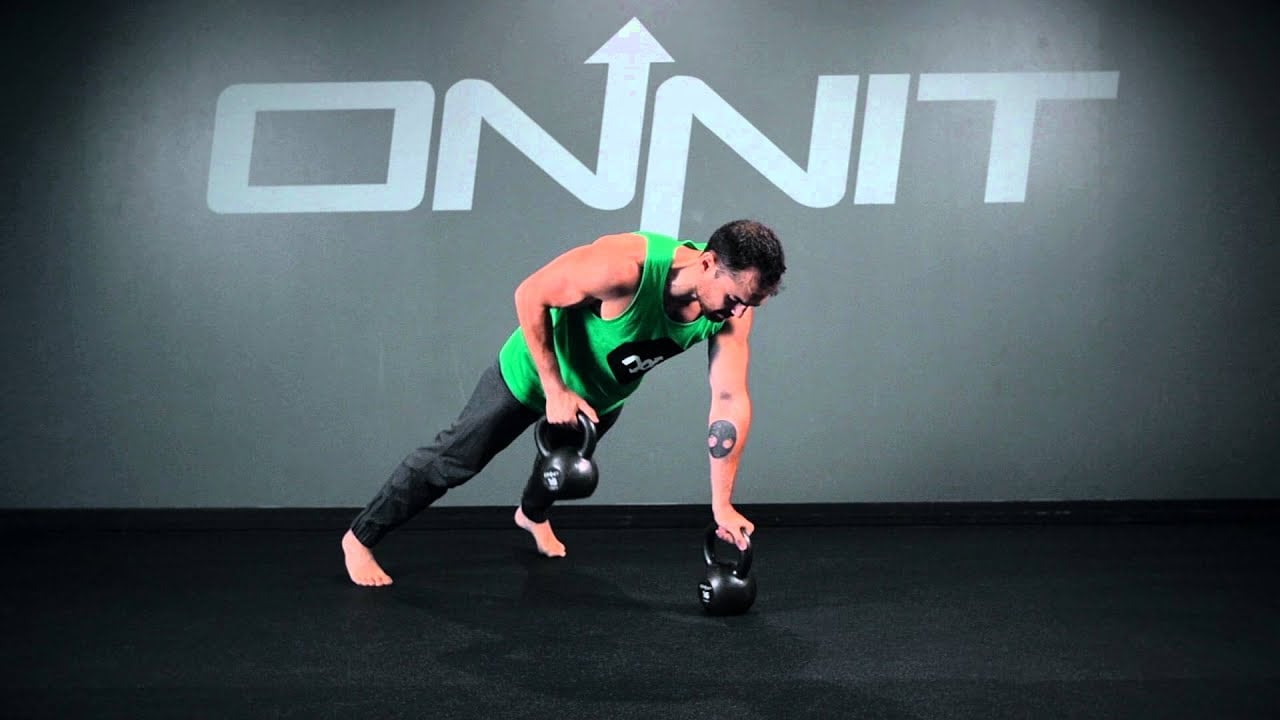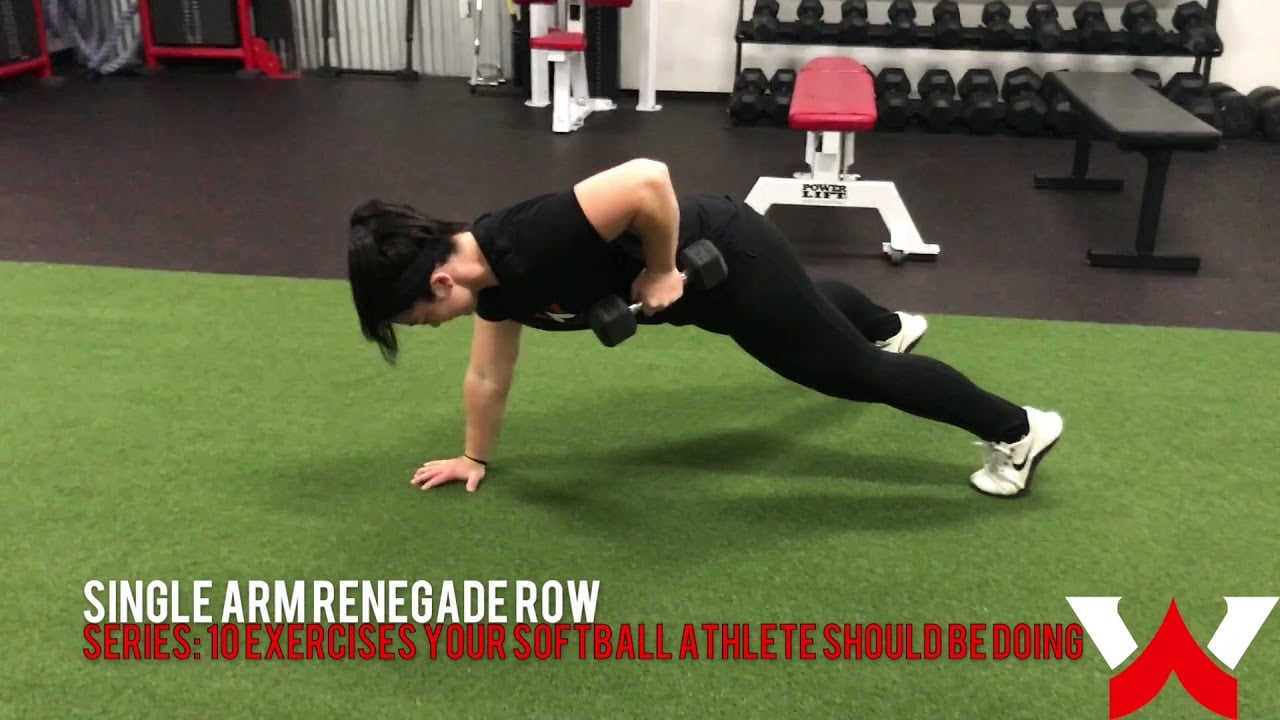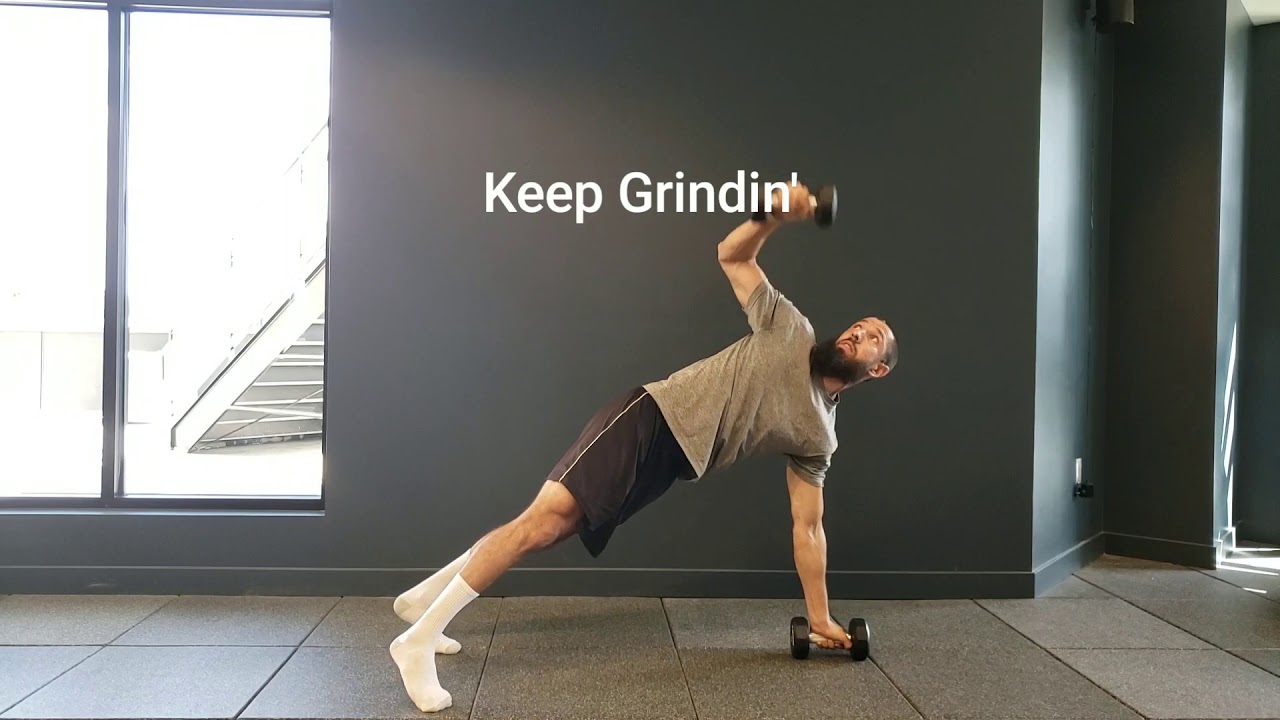The renegade row is a full-body exercise that targets the primary muscle groups of the back, shoulders, and core while also engaging the triceps, biceps, and legs.
It’s a powerful combination traditional plank and dumbbell row:
- The Strength Component: You’re rowing, hitting those key upper back muscles.
- The Stability Component: You’re holding a plank, demanding serious core, shoulder, and hip control to resist rotation.
You alternate between rowing one dumbbell up towards your chest while simultaneously stabilising your entire body with the other arm and core.
It’s a staple in my programs because it builds functional strength, core stability, and coordination with minimal equipment.
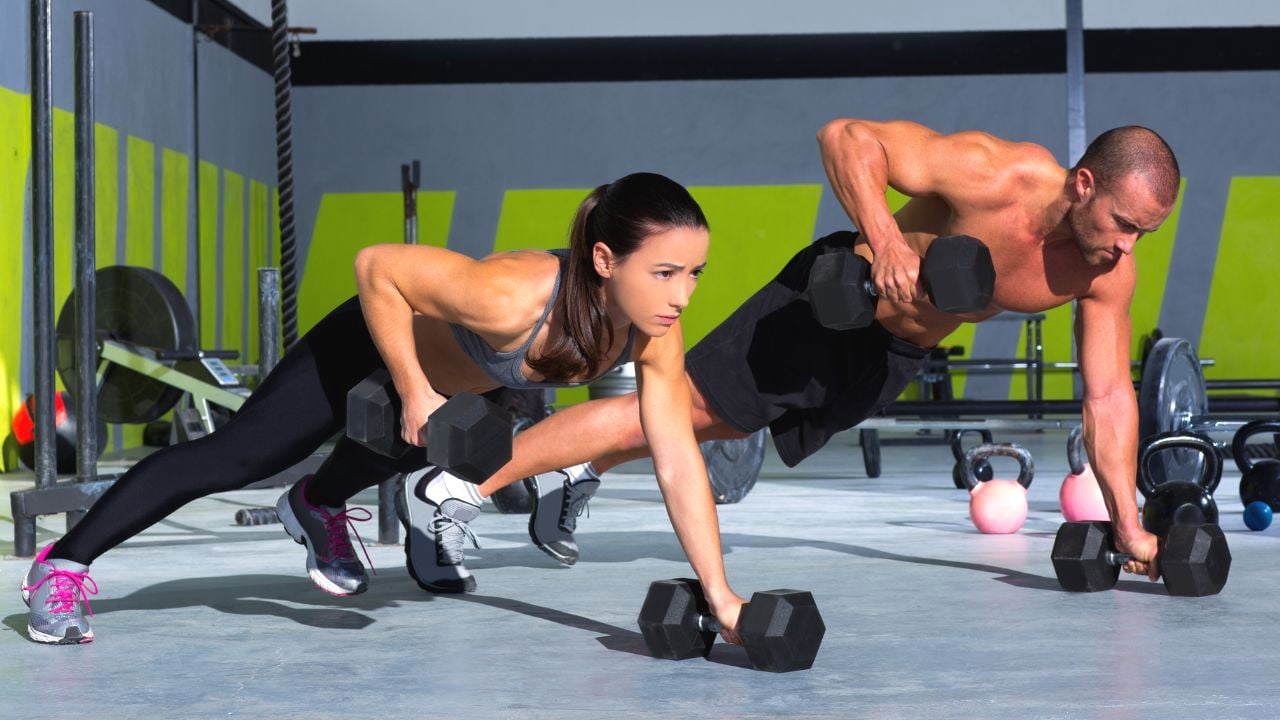
Renegade Row Muscles Worked
The renegade row is an exercise that targets multiple muscle groups, including:
- They primarily work the Back, chest muscles (pectoralis major and minor), triceps, and shoulders (deltoids).
- Additionally, they work the core muscles, the serratus anterior, which help to keep the body stable during the exercise.
- Furthermore, it is worth mentioning that the legs and glutes are indirectly targeted during renegade row.
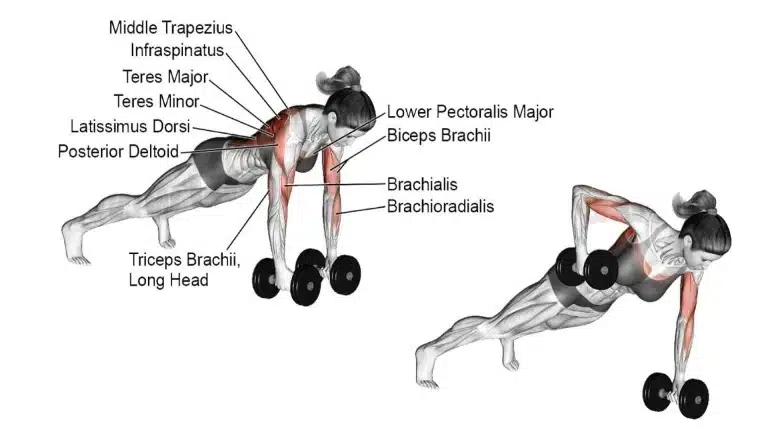
Here’s How These Muscles are engaged:
- Upper back: The row portion of the exercise specifically targets the upper back muscles, such as the rhomboids and the rear deltoids.
- Shoulders: The front and side deltoids are also heavily engaged during this time. They work to stabilize the shoulder joint and lift the weight.
- Core: The core muscles, including the abs, obliques, and transverse abdominis, keep the spine stable and prevent the hips from sagging.
- Triceps: It works to extend the elbow joint during the row.
- Biceps: It assists the triceps and shoulders during the row
- Legs: mainly the glutes and quads, work to maintain a stable plank position.
- Scapular stabilizers: The small muscles that attach to the shoulder blades (scapulas) are vital in keeping the shoulder blades stable during the exercise.
How To Do Renegade Row
- Place your two dumbbells on the floor, about shoulder-width apart.
- Get into a high plank position, gripping the dumbbell handles firmly. Your hands should be directly underneath your shoulders, your wrists straight, and your knuckles facing forward.
- Your body should form a straight line from the crown of your head down through your heels. Avoid letting your hips sag towards the floor or pike up towards the ceiling.
- Start with your feet slightly wider than hip-width apart. This gives you a wider support base and makes resisting rotation easier, especially when you’re learning. As you get stronger, you can bring your feet closer together.
- Brace your core as if you’re anticipating a punch to the stomach. Squeeze your glutes hard. This locks your torso in place.
- Maintaining that rigid body position and engaged core, exhale and pull one dumbbell straight up towards your rib cage.
- Briefly pause at the top, squeezing your back muscles. You should feel the work primarily in your upper back (lats, rhomboid).
- Inhale and slowly lower the dumbbell back to the floor with control. Don’t let it drop.
- Once the dumbbell is back on the floor and stable, re-engage your core and glutes if needed. Ensure your plank is still solid.
- Repeat steps 6-9 with the other arm.
- One row on each side typically counts as one complete repetition of the Renegade Row.
Tips and Techniques
- Do a proper warm-up before doing it. A warm-up will prepare your body for the exercise by increasing blood flow to your muscles and joints.
- When doing the renegade row, keep a neutral spine position. To do this, engage your core muscles and keep your hips. Keep your core tight, keep your body in a straight line, and maintain proper form.
- Keep control of the weights throughout the exercise, avoiding swinging or throwing them during the rowing motion.
- Before each pull, subtly retract and depress your shoulder blade. This technique has immediately improved rowing mechanics in over 80% of my clients.
- Before you lift the weight, take a breath in, and as you breathe out, squeeze your stomach and butt hard. Keep that squeeze the whole time you’re rowing. This keeps your back safe and stops you from wobbling.
- If you can’t keep your body straight or twist a lot, switch to a simpler version. Knee renegade row, or start with only your body weight before adding weights.
- When rowing, focus on squeezing your shoulder blade towards your spine, and when pushing up, focus on engaging the chest and triceps.
- Track your elbow close to your ribcage and visualise it moving slightly behind your torso at the top of the movement. According to EMG studies, this subtle adjustment increases lat engagement by approximately 20%.
- For muscle hypertrophy (muscle growth): 3–4 sets of 8–12 reps with a moderate weight. For muscle endurance, 2–3 sets of 12–15 reps should be done with a light to moderate weight.
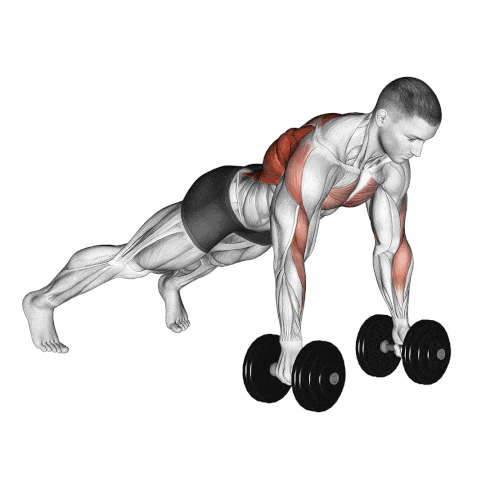
Variations of the Renegade Row
The renegade row can be done differently to suit your fitness level.
If you are new to performing it, you may want to apply a few modifications to make the exercise easier. One way to avoid this problem is to do a renegade row on your knee. Another is to use a lighter weight.
Several variations can enhance your workout results once you have mastered the basic renegade row form.
If you are looking for a more advanced variation to stimulate different muscle fibers, then try kettlebell Renegade Row, Renegade Row push-ups, and Renegade Row with a Twist.
1. Knee Renegade Row
The Knee Renegade Row is a beginner-friendly variation of the Renegade Row, that you can do on your knees instead of your full plank position.
The knee support helps keep the spine neutral by lowering the center of gravity. This adjustment reduces the risk of lumbar strain, making it especially helpful for people with weak core muscles or back problems.
2. Renegade Row Push Ups
Renegade row push ups are a compound exercise that combines a push-up with a dumbbell row.
This exercise targets the chest, triceps, shoulders, back muscles, and core.
Additionally, because it works for multiple muscle groups at once, it can be a more efficient exercise for those who are short on time.
3. Kettlebell Renegade Row
While the movement may appear similar, kettlebells provide a much less stable base.
This means you’ll need even more focus, control, and strength from your hands, wrists, shoulders, and core to keep everything steady during the plank and the row. It’s a fantastic way to progress the exercise and improve your stabilising muscles.
It can be challenging to work on grip strength, upper-body strength, and core stability.
How To Do It
- Start in a plank position with your feet shoulder-width apart and your hands placed on two kettlebells in front of you.
- Engage your core and keep your body straight from your head to your heels.
- Lift one kettlebell off the ground by rowing it towards your hip.
- Keep your elbow close to your body and your chest parallel to the ground.
- Lower the kettlebell back to the ground and repeat the same movement with the other arm.
- Continue to alternate arms, maintaining proper form throughout the exercise.
4. Single-Arm Renegade Row
The Single-arm Renegade Row is a challenging variation that can help build unilateral strength and stability.
It can be useful for athletes and anyone looking to improve their symmetry.
This variation involves performing the exercise with only one arm at a time.
It can increase the difficulty level and target the core and upper body muscles even more.
How To Do It
- Start in a plank position with one dumbbell or kettlebell on the ground.
- Start by engaging your core and keeping your body in a straight line from your head to your heels.
- With one hand, grip the weight, keeping your elbow close to your body, and lift it off the ground by rowing it towards your hip.
- Keep your core tight and maintain proper form throughout the exercise.
- Lower the weight back to the ground, then switch arms and repeat the same movement.
5. Renegade Row with a Twist
This variation involves adding a twist to the row movement.
As you row the dumbbell up to the side of your chest, you rotate your torso and twist the weight toward the ceiling.
It targets the same muscle groups as the traditional renegade row, such as the upper back, shoulders, and core, but with an emphasis on the oblique muscles and rotator cuff muscles.
It’s important to maintain proper form and control the movement, twisting only with your torso, not with your hips or legs.
References
- Saeterbakken A, Andersen V, Brudeseth A, Lund H, Fimland MS. The Effect of Performing Bi- and Unilateral Row Exercises on Core Muscle Activation. Int J Sports Med. 2015 Nov;36(11):900-5. doi: 10.1055/s-0034-1398646. Epub 2015 Jul 2. PMID: 26134664.
- Lehman GJ, Buchan DD, Lundy A, Myers N, Nalborczyk A. Variations in muscle activation levels during traditional latissimus dorsi weight training exercises: An experimental study. Dyn Med. 2004 Jun 30;3(1):4. doi: 10.1186/1476-5918-3-4. PMID: 15228624; PMCID: PMC449729.

Manish is a NASM-certified fitness and nutrition coach with over 10 years of experience in weight lifting and fat loss fitness coaching. He specializes in gym-based training and has a lot of knowledge about exercise, lifting technique, biomechanics, and more.
Through “Fit Life Regime,” he generously shares the insights he’s gained over a decade in the field. His goal is to equip others with the knowledge to start their own fitness journey.


